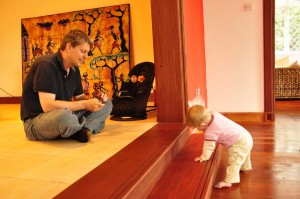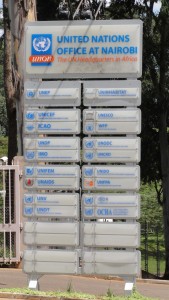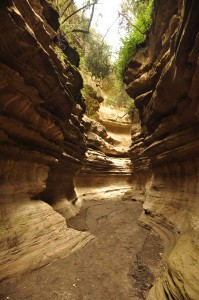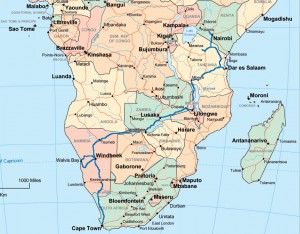After the travails of overlanding, we arrived in Nairobi, some 2 days behind schedule and on a bus that was 7 hours late – a cumulative African delay the result of crossing Tanzania by land from Malawi. Arriving in downtown Nairobi (Nai-robbery as the place is affectionately known) at a bus stand at 2am in is certainly not something any guidebook recommends. One of the toughest cities in Africa, stories of high crime abound – kidnapping, robbery and much worse. The border crossing at night from Kenya to Tanzania at night had already been an interesting experience. Midway along a 6 hour apology for a dirt road, that frequently threw you several metres into the air from your seat; the bus drops you off and proceeds through to the other side of immigration. You are then forced to walk the unlit gauntlet of no-mans land from one immigration centre to the other, while innumerable faces jump out of the dark at you demanding passports or visa payments, telling you your bus is leaving and to follow them or trying to simply change money at ridiculous rates. A hundred scams of chance playing on the nights’ confusion and traveller ignorance, to perhaps extort a profit and distract you from the task at hand.
Hardly unsurprisingly then, that we were incredibly thankful & relieved to be drifting from our usual travelling script and backpacker trail to be actually staying with friends in Nairobi. As a former working colleague of both myself and Megumi; we had known, befriended and shared many trials and tribulations of the professional ilk with James over some 6+ years in Japan. He, his wife Claudia and 9 month gorgeous baby girl, Anais, had recently relocated here from Tokyo; Claudia taking up a job with the UN Environment Programme which is headquartered in Nairobi. After our late night rendezvous with James, we were then given a tour of his recently settled, 5 bedroom house in a UN approved housing compound on the outskirts of the city, complete with several security guards and a maid. With the introduction of our own room & bathroom, a gourmet kitchen, wireless internet and the incredibly generous offer to make ourselves at home for as long as we needed; for us this was more akin to a 5 star hotel than simply crashing at a ‘friends’ place. A breath of fresh air in complete contrast to our recent African adventures, it represented a re-acquaintance with old friends, forgotten luxuries and a sense of home that we had not really experienced since Myanmar some 8 months distant now.
The last year it seems had been quite transformative on all fronts and more than just a reunion, it provided an interesting chance to reflect. Both us, and the Heines’, had experienced huge changes in the last 12 months. For them, having a baby and moving to Kenya was embarking on an exciting, if not daunting new lifestage and career in a new frontier and continent. It was a radical transition that in many ways mirrored our own travel induced evolutions. The joy of seeing James happily transformed into ‘Mr Mom’ and sharing the daily joys and development of the gorgeous Anais with them was immensely rewarding. Equally over the next 2 weeks through Claudia, we were also experienced a fascinating insight into the workings of the UN. The UN complex here employs over 2,000 people and represents the only divisional HQ of the UN based in a developing nation. More akin to a university campus than a set of office’s, it propagates an entire support community in Nairobi. The ever present symphony of cars with red UN diplomatic plates necessitates its own police force and a network of international restaurants, malls, shops and café’s that all supports a lifestyle and international community that we had not experienced since South Africa. While we were there, a large UN divisional biodiversity conference was taking place and Claudia kindly treated us to a tour. Delegates from all the UN countries were in town to meet over several days to share information, research and set / argue policies around key global biodiversity issues. Once hammered out, these policies and guidelines are fed back to their respective governments as global directives and initiatives to influence local executions and bio-diversity programmes. Perusing the display stands showing the latest information, research and policy outlines towards such subjects as biofuels, climate change, indigenous cropping and farming, all provided a fascinating insight into the role the UN is trying to play here. In all, it provided a fantastic perspective and environment that couldn’t be in more contrast with other fellow traveller’s experiences of the city. Suffice to say, that very few people had actually stuck around here for long.
Despite all our other intentions to explore Kenya though, we did not really stray far from this comfortable base. Through the shared passion and perspective imbued by James’ insights, we were able to get some appraisal of the emerging Kenyan & East African mobile, internet and infrastructure space; a glimmer of some of the ideas, opportunities and challenges inherent here. Yet apart from learning, catching up & trading tales, this was also a chance to re-equip, organize and take care of essentials ahead of our next stages of adventure. From the simple joys of being able to upload photo’s, research destinations, book plane tickets (for Iran & Morocco) and buy essentials; to visiting a professional ophthalmologist to sort out my rather serious recurring eye infection and treating ourselves to some gourmet home cooking, we found it quite hard to move. A blissful respite that we remain incredibly grateful for!
The one exception to this was a four day escape a few hours north of Nairobi to do some hiking and explore some of the more accessible and stunning Rift Valley and Lakeside national parks. Via matatu (Kenyan mini-buses) we first made our way to Navaisha, a large lake famous for its flowers and decadent expat behaviour in the 1930’s, made famous by the book “Out of Africa’. Staying at Fisherman’s camp, a beautiful campsite by Lake Navaisha, replete with a local population of captivating black & white Colobus monkeys and surrounded by an electrical fence to keep out the innumerable nocturnal grazing hippo’s; we used this as a base to explore the nearby Hell’s Gate National park on foot. A simple attempt to get some fitness and exercise, while exploring the stunning gorge on Masai land, made famous as sets in the Indiana Jones and TombRaider movies. From Navaisha, we then travelled north to the soda lakes and National Park of Nakuru. Famous for its resident population of 1 million pink flamingos; we chartered a car and circumnavigated the lake as part of a 6 hour tour. As well as a variety of now very familiar African game in the form of buffalo’s, zebra, giraffe, gazelle and hyena, we managed to see more than a dozen white rhino, casually grazing around the edges of the Lake; a fantastic contrast and photographic juxtaposition with the stunning, pink profusion of the flamingos, pelicans and storks – all diligently feeding on the lakes algae.
Reluctantly and indebtedly after a stay of a little more than 2 weeks, we forced ourselves to uproot and move on. We only had 3 weeks left in East Africa before flying to Egypt and had now managed to organize ourselves for a tightly run Tanzanian trifecta to finish – climbing Kilimanjaro the highest mountain in Africa; a safari to explore the Serengeti and Ngorongoro Crater and a final week exploring the exotic Arabic, tropical spice island paradise of the Zanzibar archipelago. With the sorrow of departures, balanced by the excitement of new stages of adventure, we bade a sad farewell to our wonderful hosts, we leave Kenya still largely unexplored, but in doing so, leave plenty of room for a future return…
![‘Hotel Heine’, Kenya After the travails of overlanding, we arrived in Nairobi, some 2 days behind schedule and on a bus that was 7 hours late – a […]](http://meltingplots.com/wp-content/uploads/2010/05/Flamingo1.jpg)



![Overlanding Africa When travelling, it seems no matter where you are, you still operate in a kind of bubble. You move in an almost semi-detached observer capacity […]](http://meltingplots.com/wp-content/uploads/2010/05/BusTop.jpg)
